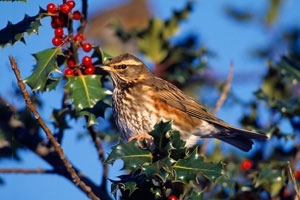Fieldfare (Turdus pilaris) and redwing (Turdus iliacus)
 As autumn turns to winter, many of our summer migrants are replaced by those who choose to spend the winter months with us. Two members of the thrush family, the fieldfare and redwing arrive in great numbers on our eastern coasts, having crossed the North Sea from their breeding grounds in the northern regions of Europe, Scandinavia and Asia. Fieldfare are large, colourful thrushes with grey head and rump and a rich brown back, and have a rather upright stance when on the ground. You most often become aware of them as a flock flies overhead, alerted to their presence by the constant harsh chattering “chak, chak, chak” call they make.
As autumn turns to winter, many of our summer migrants are replaced by those who choose to spend the winter months with us. Two members of the thrush family, the fieldfare and redwing arrive in great numbers on our eastern coasts, having crossed the North Sea from their breeding grounds in the northern regions of Europe, Scandinavia and Asia. Fieldfare are large, colourful thrushes with grey head and rump and a rich brown back, and have a rather upright stance when on the ground. You most often become aware of them as a flock flies overhead, alerted to their presence by the constant harsh chattering “chak, chak, chak” call they make.
The redwing is far more like our resident song thrush, but a closer look will reveal a distinctive white line that runs across the top of the eye (known as a supercilium) and also reddish flanks under the wings – which gives the bird its name. As with many birds, redwing often migrate at night and if you have reasonable hearing, try going outside after dark on a night that is not too windy and see if you can hear the short, high pitched “seeip” that they make as they fly overhead. At this time of year I would be disappointed if I had not heard one within five minutes – so give it a go! (The crafty smokers among you now have a new excuse!) In fact, we probably all imagine that apart from the odd owl and a late bat or two, there is very little flying around after dark at this time of the year. However, many birds migrate at night using the stars, the earth's magnetic field and wind directions to aid navigation.
These wintering thrushes join other resident thrushes such as the blackbird, song and mistle thrush, to gorge themselves on the berry harvest. Farmers are encouraged to cut their hedges on a rotational basis as most blossom and therefore berries occur on second year growth, so a hedge cut every year yields very little food. Once a hedge with plenty of hawthorn, buckthorn and guelder rose berries is located, all these species can be found feeding together in flocks of up to a couple of hundred individuals. Once these berries start to dwindle a bit, you can find both redwing and fieldfare turning their attentions to your garden cotoneaster and apple trees, including crab apples. Fieldfare in particular can be really quite aggressive towards other birds and can “claim” a small tree such as a crab apple and its produce as their property, spending much of a short winter day chasing the competition away.
In the spring, both redwing and fieldfare will sometimes gather together in big flocks and sing. I have come across flocks of several hundred sitting in the tops of trees and the noise they make can be heard some distance away. As most birds sing to attract a mate and to declare ownership of a territory, I can only imagine that with their breeding grounds a long way off they are simply “oiling” the vocal chords in preparation for their return home!
Peter Thompson
Advisory

Download Peter Thompson's essential 26-page book, featuring beautiful photography and detailed profiles of Britain's wildlife
Download FREE >